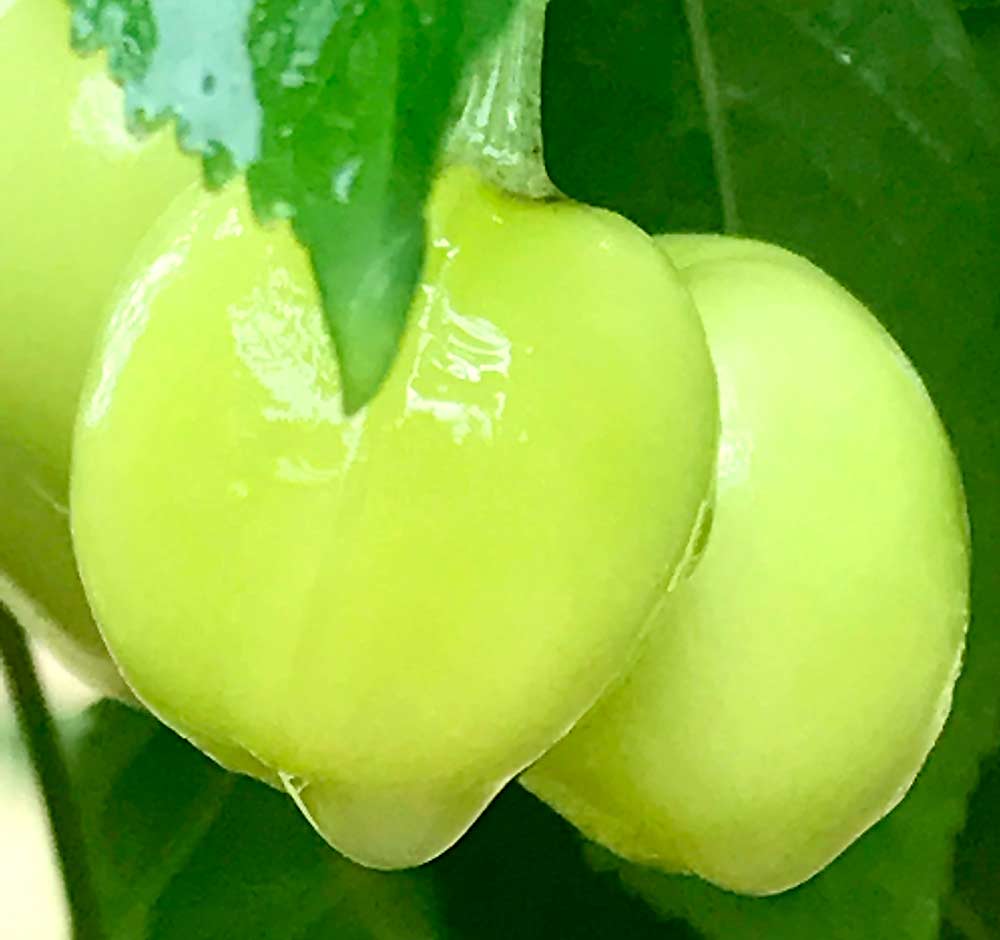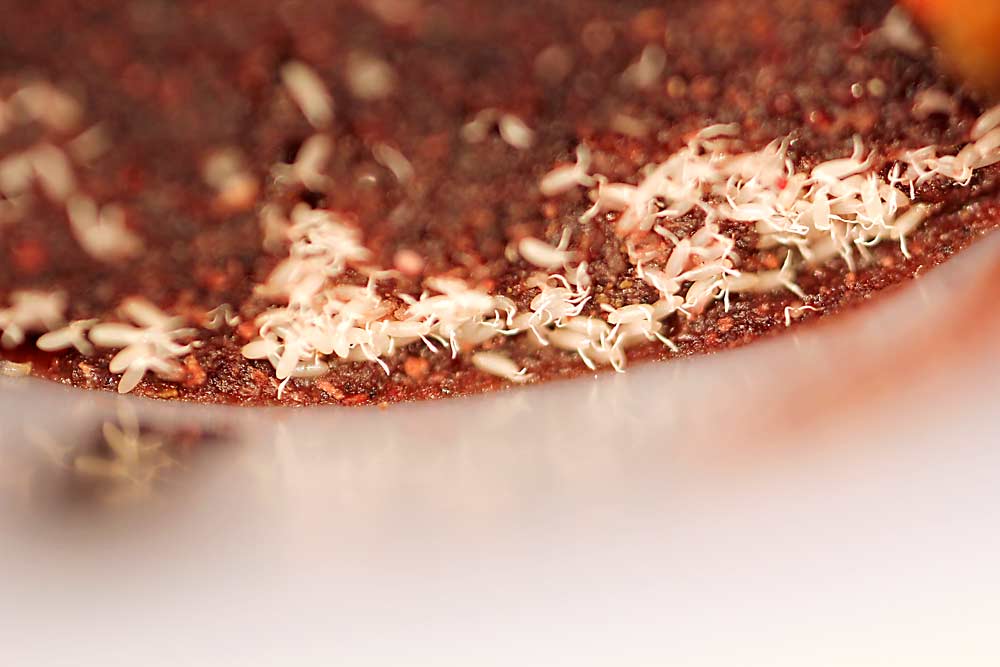
OSU researcher Valerio Rossi Stacconi checks on caged blueberry bushes as part of an experiment assessing behavior of spotted wing drosophila in the presence of a new behavior-disrupting product. (Courtesy Valerio Rossi Stacconi)
Spotted wing drosophila’s fearsome superpower lies in the fruit flies’ ability to lay eggs in intact cherries, berries and other soft fruits, long before their native cousins. So, when Oregon State University horticulturist Clive Kaiser developed a protective coating that reduced cracking in cherries, his colleagues in the entomology program wanted to see if the coating could cut into SWD damage.
It didn’t.
The coating struck out again when researchers in California wanted to see if it could reduce water use in almonds.
But those two questions sent Kaiser back to the drawing board to create a new, thicker coating that could deter SWD and reduce water needs. For inspiration, he turned to the naturally thick cuticle of drought-adapted desert plants — and the resulting research has borne two new products that could make life easier for growers battling SWD.
The first product simulates naturally occurring cuticles, using food-grade, plant-derived products. “Even though it is an artificial coating, it’s made of the same components” as in desert plants, he said of the patent-pending coating now referred to as HydroShield.

A new coating for cherries, as seen here, blueberries, grapes and other soft fruit mimics the thicker cuticle of desert plants, reduces damage from spotted wing drosophila and cuts water demand, at least in wine grapes, according to Clive Kaiser, the Oregon State University extension horticulturist who developed the patent-pending product made entirely of food-grade materials. (Courtesy Clive Kaiser/Oregon State University)
Kaiser began testing HydroShield on wine grapes in Eastern Oregon to assess the impact on water use (see “Cutting water demand in the vineyard” on Page 22) and then partnered with OSU entomologist Vaughn Walton to see how the artificial cuticle could protect soft fruits from SWD.
In the process of testing various formulations, Walton found that one batch of coating Kaiser sent actually attracted SWD rather than deterred them. So much so, in fact, Walton and his postdoctoral researcher, Valerio Rossi Stacconi, realized that the coating’s appeal was powerful enough to be turned into a separate pest-control product.
“We call it a behavioral disruptor,” Rossi Stacconi said of the mix of attractive compounds which form a gum that appears to lure SWD away from fruit. “Mating, feeding, laying eggs, all these activities are done on the synthetic fruit we offer to the pest.”
The two products — the coating and the attractive gum, both made of food-grade materials with the potential for organic certification — could present the first nonpesticidal controls for SWD to make it to market in the next few years.
The research is funded by VertueLab (formerly known as Oregon Best), the Oregon Blueberry Commission and the Oregon Department of Agriculture.
Coat of armor
HydroShield works because it creates a barrier 90 microns thick, comparable to the cuticle of many desert plants, Kaiser said. The mix of microcrystalline cellulose, pectins and fatty acids is sprayed on in a solution and then the water expresses out, leaving the film that acts as an extra cuticle.
“It creates a 10-percent increase in penetrating value. That doesn’t sound like a lot, but it’s more than enough” to limit SWD damage in blueberries, Walton said.
That’s because blueberries’ natural firmness alone nearly thwarts SWD’s penetrating power, and the coating boosts defenses enough to reduce egg laying by 90 percent over 30 days after application, he said.
In cherries, which are inherently softer and at greater risk, it reduces egg laying only by about 25 percent, Walton said.
Kaiser expects OSU to license HydroShield to the same manufacturer that makes SureSeal, the anti-cracking coating he previously worked on. There’s a chance HydroShield could be available this season, but more likely by 2020.
“Because it’s pest-avoidance, it doesn’t have to have an EPA registration,” Kaiser said.
Under a conditional-use permit, organic growers will be able to use HydroShield, but only as a surfactant, not as a standalone product, Kaiser said, based on how the components are already registered with the National Organic Standards Board. Kaiser recommended using it in conjunction with PyGanic (pyrethrins), because the pesticide will break down quickly as it does its work, leaving the coating intact on the berry surface.
Decoy fruit
After the initial discovery of compounds that appealed to SWD, the OSU researchers began to build a product that would act like an artificial fruit. Over nearly 100 iterations, they refined the mix of food-grade components so that it would have high-powered, long-lasting appeal to the pest.
“The best way to describe it is a behavioral disruptor, because it disrupts the flies’ behavior and their egg laying,” Walton said. “It reduces their ability to find the fruit and lay their eggs in the fruit.”
The patent-pending product has the consistency of a gum, and, over time, contact with it dehydrates the flies and their eggs, which prevents the eggs from hatching.

Spotted wing drosophila prefer to hang out and lay eggs on this patent-pending gum developed by Oregon State University researchers. Eggs then desiccate, so this behavior-disrupting product could help growers reduce pest pressure significantly on soft fruits, without pesticides.(Courtesy Valerio Rossi Stacconi/Oregon State University)
Field-scale trials in blueberries last summer showed that the gum continues to attract SWD for three weeks and reduces egg laying in fruit by 83 percent, Rossi Stacconi said. “For many crops, this is enough to cover the entire fruiting period,” he said, which may be quite favorable compared to intensive spray programs to control the pest.
Smaller scale trials with nets around clusters of fruit and high SWD pressure have shown the gum also cuts egg laying in half in cherries, strawberries, raspberries and wine grapes.
More work needs to be done to figure out how to deploy the pest-disrupting gum, which needs to stay moist to remain effective.
Last year’s experiments used microfiber cloths hung near drip emitters, but that was not very practical for commercial use, Rossi Stacconi said. Those trials also used the equivalent of 100 point sources per acre of blueberries, but he thinks that can be significantly reduced in upcoming experiments with bigger cages and open field trials.
Walton is working with OSU’s commercial development team to find an interested manufacturer, and he hopes the product can be available to growers in 2020. •
—by Kate Prengaman






Leave A Comment